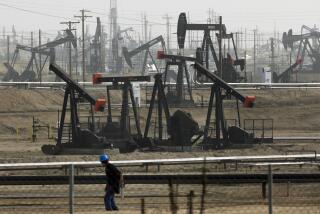Lettuce Samples Found Tainted
A laboratory test of 22 types of lettuce purchased at Northern California supermarkets found that four were contaminated with perchlorate, a toxic rocket-fuel ingredient that has polluted the Colorado River, the source of the water used to grow most of the nation’s winter vegetables.
The environmental group that paid for the testing by Texas Tech University conceded that the sample was far too small to draw definite conclusions about how much perchlorate is in the lettuce Americans eat. But the organization, the Environmental Working Group, said the results were alarming enough to warrant a broad examination by the Food and Drug Administration.
“It appears perchlorate in produce is reaching consumers, which should be a wake-up call for the FDA,” said Bill Walker, a western representative in the group’s Oakland office. “A lot of people might look at this and say it was only four out of 22 -- what is the problem? Well, when nearly one in five samples of a common produce item are contaminated with a chemical component of rocket fuel, that’s significant.”
In response, FDA officials said they had been planning to begin testing foods for perchlorate at a number of sites across the country, but were still developing the scientific methods to do it.
“We do understand that there is a potential for perchlorate from irrigation water to end up in food,” said Terry Troxell, the director of the FDA’s office of plant and dairy foods and beverages. “We have already been moving in this area. We will certainly take their results into account.”
The four lettuce samples all contained substantial quantities of perchlorate. One, a packaged variety of organic mixed baby greens, had a level of perchlorate contamination at least 20 times as high as the amount California considers safe for drinking water. The other three were packaged butter lettuce and radicchio, romaine lettuce and radicchio and a head of iceberg lettuce. All were at least five times as high as the state considers safe for water.
State and federal environmental officials believe that perchlorate, a salt widely used by the U.S. government to help power missiles and the space shuttle, may cause health problems, even in trace amounts. Because it is known to affect the production of thyroid hormones, which are critical to early brain development, researchers believe perchlorate exposure may be especially dangerous for pregnant women and young children.
But the Pentagon and defense contractors, who together produced most of the nation’s perchlorate, dispute those conclusions, saying their scientists believe it poses a health threat only in doses dozens of times higher.
No Standards Set
No state or federal agency has set any enforceable health standards for perchlorate in water and food. But several are developing them, including the California Department of Health Services and the U.S. Environmental Protection Agency.
Agriculture groups, which note that the perchlorate in produce is believed to come from the water that farmers use to irrigate crops, not from pesticides, urged swift government action.
“This is a problem. It’s not one we created, but it’s one we are concerned about. We want the leading regulatory agencies to address this problem as soon as possible,” said Hank Giclas, a vice president of the Western Growers Assn., whose members grow, pack and ship 90% of the fresh vegetables and 70% of the fresh fruit and nuts in California and Arizona. “In the meantime, we want people to continue eating fruits and vegetables.”
The EPA declined to make its perchlorate experts available to discuss the Environmental Working Group’s findings, which they were permitted to review. A statement released by the agency’s headquarters said that the EPA would not make additional comment on the contaminant until the National Academy of Sciences completes an independent peer review it is conducting of EPA’s work to date on perchlorate and human health.
Perchlorate has become a volatile political issue in recent months. Democrats have accused the military of foot dragging and have demanded faster federal action; Republicans have called for further scientific research and cautioned against a rush to judgment.
Democratic Sens. Dianne Feinstein and Barbara Boxer of California and Harry Reid of Nevada wrote Defense Secretary Donald H. Rumsfeld earlier this month and asked the Department of Defense to “take a more aggressive and positive role” in cleanup efforts. They noted that “nearly all the perchlorate produced in the United States over the last half century was used by the department and our space program.”
Exemption Proposed
At the same time, a Bush administration proposal known as the Readiness and Range Preservation Initiative is making its way through the GOP-controlled Congress. Among other things, it would exempt military bases from laws requiring the cleanup of toxic substances associated with munitions and other explosives, which include perchlorate.
The nationwide price tag of perchlorate cleanup could be in the tens of millions, and possibly even billions, of dollars, according to water officials and other experts, who say it has the potential to dwarf California’s problems with MTBE, a gasoline additive that tainted groundwater supplies. Perchlorate, which is highly soluble, has been detected in water supplies in California and at least 19 other states, usually near defense contractors or military bases. The Colorado River, which supplies drinking water to about 15 million people in the Southwestern United States, contains perchlorate that leached from the site of a former Nevada rocket fuel factory.
Environmental groups have warned that perchlorate may also be widely present in vegetables, because countless crops are irrigated with water from the same tainted sources.
Few Studies Done
There have been only a few limited studies on perchlorate and plants so far, including an EPA study of lettuce seedlings and a 1997 study of lettuce grown in the San Bernardino area by Lucky Farms. They suggest the substance may concentrate in plants. But industry groups have questioned the results, noting that the government has yet to establish a standardized system for testing perchlorate in plants, as it has done with testing in water.
“It’s a lot more difficult to test in plants than in water,” said Dr. John Gibbs, medical director for Kerr-McGee Corp., owner of the former Nevada perchlorate factory that has contaminated the river.
Gibbs said it was important to determine how the lettuce was grown, because some fertilizers contain perchlorate.
Todd Anderson, a professor of environmental toxicology at Texas Tech who conducted the lab tests, said they reflected a conservative estimate of the amount of perchlorate in the lettuce. If anything, Anderson said, more of the 22 lettuce samples might have contained some perchlorate, because the test method used could detect the contaminant only at levels 10 times as high as the tests used to measure perchlorate in water.
“We are very confident in this data,” Anderson said.
The EPA and the California Office of Environmental Health Hazard Assessment are working independently to set the nation’s first enforceable standards on perchlorate.
California officials have released a preliminary public health goal of two to six parts per billion for perchlorate in water. The EPA disclosed a draft number of one part per billion, but later clarified that it was premature.
The lower Colorado River is somewhere from five to eight parts per billion perchlorate as it flows through the fertile farm country of Arizona and California, where 70% of the nation’s winter lettuce is grown from October to March.
The four types of lettuce that tested positive in the Environmental Working Group sample all had at least 30 to 40 parts per billion perchlorate. The organic lettuce registered 120 parts per billion. One part per billion is roughly equivalent to a drop of water in a residential swimming pool.
The Environmental Working Group declined to disclose the brands of lettuce that contained contamination, or where they had been purchased, saying it was wary of triggering a food scare.
But it said it had bought the lettuce at supermarkets in Northern California in January, when about 88% of the nation’s lettuce comes from farms nourished with water from the Colorado River.






